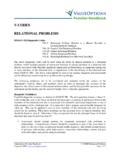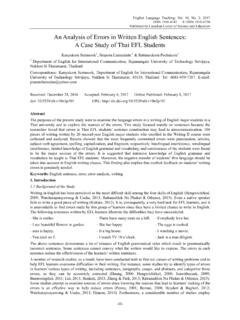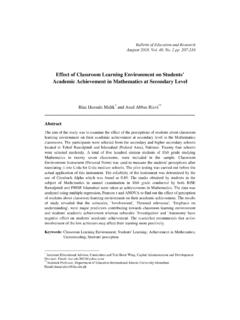Transcription of An Introduction to Sentiment Analysis
1 An Introduction to Sentiment AnalysisAshish KatrekarAVP, Big Data AnalyticsSentiment Analysis and opinion mining have become an integral part of the product marketing and user experience as both businesses and consumers turn to online resources for feedback on products and services. This white paper explores the evolution and challenges of Sentiment anaysis, as well as how to best leverage Introduction to Sentiment AnalysisAshish Katrekar, AVP, Big Data AnalyticsGlobalLogic 2 Table of ContentsIntroduction.
2 Sentiment Classification Levels .. Document Level Classification .. Sentence Level Classification ..Converting Unstructured Text into Structured Opinions ..Aspect Based Sentimental Analysis .. Aspect Extraction .. Sentiment Classification .. Finding Sentiments for Aspects ..Conclusion ..References ..33334455566An Introduction to Sentiment AnalysisAshish Katrekar, AVP, Big Data AnalyticsGlobalLogic 3 IntroductionThe opinions of others have a significant influence in our daily decision-making process.
3 These decisions range from buying a product such as a smart phone to making investments to choosing a school all decisions that affect various aspects of our daily life. Before the Internet, people would seek opinions on products and services from sources such as friends, relatives, or consumer reports. However, in the Internet era, it is much easier to collect diverse opinions from different people around the world. People look to review sites ( , CNET, ), e-commerce sites ( , Amazon, eBay), online opinion sites ( , TripAdvisor, Rotten Tomatoes, Yelp) and social media ( , Facebook, Twitter) to get feedback on how a particular product or service may be perceived in the market.
4 Similarly, organizations use surveys, opinion polls, and social media as a mechanism to obtain feedback on their products and services. Sentiment Analysis or opinion mining is the computational study of opinions, sentiments, and emotions expressed in text. The use of Sentiment Analysis is becoming more widely leveraged because the information it yields can result in the monetization of products and services. For example, by obtaining consumer feedback on a marketing campaign, an organization can measure the campaign s success or learn how to adjust it for greater success.
5 Product feedback is also helpful in building better products, which can have a direct impact on revenue, as well as comparing competitor offerings. This white paper will describe the various types of Sentiment classification, explore how to convert unstructured text into structured opinions, and address the current challenges in the Classification LevelsSentiment Analysis can occur at different levels: document level, sentence level or aspect/feature level. Document Level Classification In this process, Sentiment is extracted from the entire review, and a whole opinion is classified based on the overall Sentiment of the opinion holder.
6 The goal is to classify a review as positive, negative, or neutral. Example I bought an iPhone a few days ago. It is such a nice phone, although a little large. The touch screen is cool. The voice quality is clear too. I simply love it! Is the review classification positive or negative? Document level classification works best when the document is written by a single person and expresses an opinion/ Sentiment on a single entity. Sentence Level Classification This process usually involves two steps: Subjectivity classification of a sentence into one of two classes: objective and subjective Sentiment classification of subjective sentences into two classes: positive and negativeAn objective sentence presents some factual information, while a subjective sentence expresses personal feelings, views, emotions, or beliefs.
7 Subjective sentence identification can be achieved through different methods such as Na ve Bayesian classification. However, just knowing that sentences have a positive or negative opinion is not sufficient. This is an intermediate step that helps filter out sentences with no opinions and helps determine to an extent if sentiments about entities and their aspects are positive or negative. A subjective sentence may contain multiple opinions and subjective and factual clauses. An Introduction to Sentiment AnalysisAshish Katrekar, AVP, Big Data AnalyticsGlobalLogic 4 Example iPhone sales are doing well in this bad economy.
8 Sentiment classification at both the document and sentence levels are useful, but they do not find what people like or dislike, nor do they identify opinion targets. Aspect/Feature Level ClassificationIn this process, the goal is to identify and extract object features that have been commented on by the opinion holder and determine whether the opinion is positive, negative, or neutral. Feature synonyms are grouped, and a feature-based summary of multiple reviews is produced. Converting Unstructured Text into Structured OpinionsConsumer sentiments are mainly expressed in an unstructured format.
9 Text Analysis involves taking unstructured data and finding ways to convert it into a more structured format that facilitates Analysis of data and getting deeper insights into the sentiments. There are various techniques that can be used to convert unstructured data into a structured format. One such way is to express an opinion as a quintuple (ej, ajk, soijkl, hi, tl), where: ej is a target entity ajk is an aspect/feature of the entity ej soijkl is the Sentiment value of the opinion from the opinion holder soijkl is +ve, -ve, or neutral, or more granular ratings hi is an opinion holder tl is the time when the opinion is expressed An entity e is a product, person, event, organization, or topic and is represented as an hierarchy of components, sub-components, and so on.
10 Each node is represented as a component and is associated with a set of attributes for the component. ExampleReview from XYZ on 7/8/2013 - I purchased a Galaxy 5S phone. It is a great phone overall. The screen resolution is cool and has a good battery life. This opinion can be expressed by the following quintuples:(Galaxy 5S, screen, +, XYZ, 7/8/2013)(Galaxy 5S, battery, +, XYZ, 7/8/2013)Quintuples form the basis for opinion summarization. The objective of the quintuple is to convert the unstructured data to a more structured form that can be used for further Analysis .









